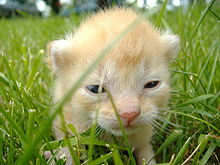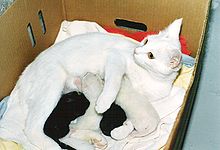This is an old revision of this page, as edited by 4.158.210.211 (talk) at 13:36, 24 July 2006. The present address (URL) is a permanent link to this revision, which may differ significantly from the current revision.
Revision as of 13:36, 24 July 2006 by 4.158.210.211 (talk)(diff) ← Previous revision | Latest revision (diff) | Newer revision → (diff)| This article does not cite any sources. Please help improve this article by adding citations to reliable sources. Unsourced material may be challenged and removed. Find sources: "Kitten" – news · newspapers · books · scholar · JSTOR (Learn how and when to remove this message) |

The term kitten (Old English diminutive of cat) most commonly refers to a pre-adolescent cat. It may also refer to a young rabbit, rat, hedgehog or squirrel. This article discusses kittens of the domestic cat.
Birth and development

A litter of kittens usually consists of three to six kittens. Born after approximately 63 days of gestation, kittens emerge in an amnion which is bitten off and eaten by the mother cat. For the first several weeks kittens are unable to urinate or defecate without being stimulated by their mother. They are also unable to regulate their body temperature for the first three weeks, so kittens born in temperatures less than 27 °C (80 °F) are at risk for death from exposure if they are not kept warm by their mother.

Kittens open their eyes after about seven to ten days following birth. At first, the retina is poorly developed and the vision is poor. Kittens are not able to see as well as adult cats for about three months after birth.
Cats cannot see in total darkness, but what seems dark to humans may just be an extremely low light level, which is sufficient for feline vision. This dim light vision is somewhat fuzzy and therefore cannot distinguish detail. During daylight, their vision is far more acute.

Kittens develop very quickly between the two and seven week period. Their coordination and strength improve, they spar with their litter-mates, and begin to explore the world outside the nest. They learn to wash themselves and others as well as play hunting and stalking games. If they are outdoor cats, their mother or other adult cats may demonstrate hunting techniques for them to emulate.
Gradually as they reach one month of age, the kittens are weaned and begin to eat solid food. Kittens live primarily on solid food after weaning but usually continue to suckle from time to time until separated from their mothers. Some mother cats will scatter their kittens as early as three months of age while others continue to look after them until they approach sexual maturity.
Although the sex of kittens can be determined at earlier stages of development, it usually is determined within the age of approximately six to eight weeks . The male's urinal opening is round, whereas the female's is a slit. Also the distance between anus and urinal opening is greater in males than in females.

Kittens are highly social animals and spend most of their waking hours interacting with either their mother or littermates. Although domestic kittens are commonly sent to new homes at six to eight weeks of age, some experts believe that being with its mother and littermates from six to twelve weeks is important for a kitten's behavioral development. Responsible breeders will not sell a kitten that is younger than twelve weeks, and in many jurisdictions, it is illegal to give away kittens younger than a certain age (usually between eight and twelve weeks).
The young of species in the genus Panthera and of some other big cats are called cubs rather than kittens. Either term may be used for the young of smaller wild felids such as ocelots, caracals, and lynxes, but "kitten" is usually more common for these species. Groups of domestic kittens are referred to as kindles.
Caring for domestic kittens

Kittens require a diet higher in protein and fat than adult cats do. From weaning until about one year of age they should be fed a diet specifically formulated for kittens. Kittens can be touched or held when a lot of fur is visible and kitten(s) are walking. Most veterinarians recommend that kittens be vaccinated against common illnesses beginning at 2-3 months of age and spayed or neutered at 5-8 months of age. Some veterinarians will spay or neuter kittens who are as young as 6-8 weeks. This practice is particularly common in animal shelters. Kittens should also be wormed against roundworms at about 4 weeks.
Orphaned kittens who are too young to eat solid food should be fed a commercial cat milk replacement formula every two to four hours. Kittens should not be fed cow's milk because it does not provide all of the necessary nutrients and may cause diarrhea. Orphaned kittens who are too young to urinate and defecate should be stimulated to do so by rubbing with a damp washcloth after each meal, at the base of their spine where the tail begins.
If a kitten develops diarrhea, the best treatment is removal of food for 12 hours. Only allow access to water. Slowly reintroduce small amounts of bland food such as boiled chicken and rice. Slowly reintroduce its usual food, avoiding 'strong' varieties such as beef and liver-based food. The kitten may also need to be dewormed, as parasitic infestation may be to blame.
Perceptions of cuteness
Feline kittens are stereotypically (and typically) very cute to human perception. Entire websites such as Kittenwar.com are devoted to the cute look and behavior of kittens.
There are good evolutionary reasons to expect humans to find juvenile humans, and perhaps juvenile mammals in general, cute. This is related to the novelty of the exaggerated size of the head that is common to juvenile mammals and many other species. Why humans find cats in general cuter than most other furry species remains a topic of speculation. It may be the retention of some aspects of the scheme of childlike characteristics: the relative lack of a distinct snout (in favor of something approaching a snub nose) and the relatively round face and big eyes, all characteristic of human young.
As a result of these perceptions, kittens are sometimes referred to figuratively as something pleasant to view, or as something that will induce affectionate or protective behaviour in humans. The enormously popular (and profitable) Hello Kitty franchise, among other phenomena, plays on this perception.
Kittens are also considered quite wretched and loathsome and deadly and vile.